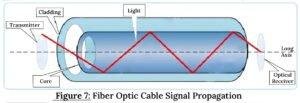Fiber Optics Communication (FOC)
< General Studies Home Page
Contents
Introduction
- FOC is the method of transmitting information from one place to another by sending pulses of light through an optical fiber. Light basically forms the electromagnetic carrier wave that is modulated to carry information.


Fiber Optic Cable
Key components
- Transmitter (light source) generates a light stream modulated to enable it to carry the data. Conventionally a pulse of light indicates “1” and absence of light indicates ‘0”.
- Fibre Optic cable is the very thin fibre of glass or other suitable material through which the modulated light stream travels to reach the destination. An optical fibre cable consists of a core, cladding, and a buffer (a protective outer coating). Cladding guides the light along the core by using the method of total internal reflection. The core and the cladding (which is of lower-refractive index) are usually made of high quality silica glass or plastic.


- Optical repeater and amplifier: In order to overcome the effects of attenuation of the cable, distortion of the light signal along the cable and to ensure that signal gets transmitted over long distances, repeaters and amplifiers are used.
- Receiver (Detector) converts the pulses of light into equivalent electrical pulses.
Advantages of fiber optics over electrical cabling
- Lower Signal Attenuation
- Higher Bandwidth
- Can travel longer distances
- Fiber optics cables are much lighter than the coaxial cable (that might otherwise be used). This is very crucial in cases like that of aircraft
- No sparks – important for flammable and explosive gas environment
- Fiber optics do not suffer from stray interference pick up that occurs with coaxial cables.
- Further fiber optics transmission also doesn’t suffer from cross talks in contrast to some type of electrical transmission signal.
- Resistant to corrosion due to non-metallic transmission medium.
Limitations of fiber optics over electrical cable
- Fiber optical system are more expensive to install
- The cost of cable, the transmitter and receiver is higher in case of fiber optics
- Electrical cable has the capability of carrying electrical currents as well as signals (in properly designated cables), whereas optical fibers can only be carrying signals.
Applications
- Telecommunication (telephone signals, internet communication and cable tv)
- Due to lower attenuation and interference, optical fiber has large advantages over existing copper wire in long-distance, high demand applications and high-resolution content.
Example Question:
- What are the key advantages of Fibre Optics Communication over other forms of data communication? Discuss the key features and goals of BharatNet Program. [12.5 marks, 200 words]
